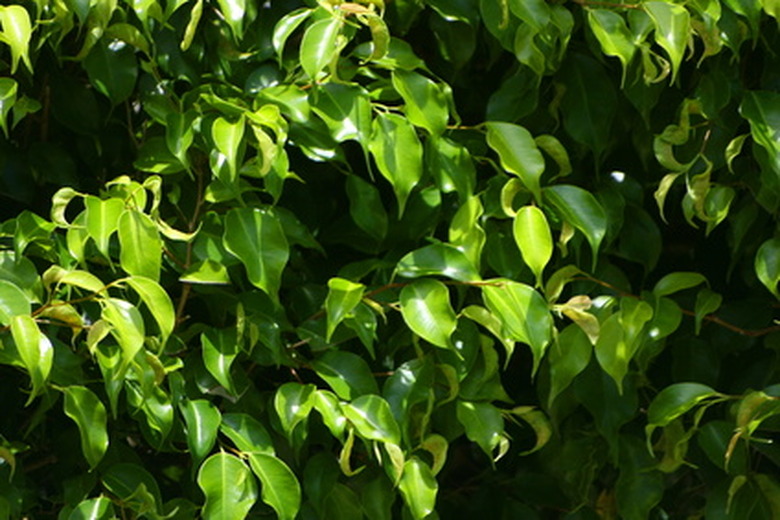How To Propagate Ficus Benjamina
Things Needed
- Chlorine bleach
- 2- to 3-inch diameter containers
- Potting soil or peat moss
- Perlite
- Pruning shears or sharp kitchen shears
- Rooting hormone
- Dibble or pencil-sized stick
- Gloves (optional)
Ficus benjamina, or weeping fig, is a popular houseplant due to its easy care, graceful, drooping limbs and shiny, dark-green leaves. Weeping fig thrives in low light and only needs minimal fertilization. It has few pests, and those are easily controlled with natural pesticides. If you have a weeping fig, you'll want to share it, and luckily, it is easily propagated from cuttings. Cuttings root readily and grow quickly, producing an abundance of plants to share with your gardening friends.
Step 1
Clean the pruning shears and potting surface with a solution of one part household bleach to 10 parts water. This will avoid spreading any pathogens into the plant or onto the cuttings.
- Ficus benjamina, or weeping fig, is a popular houseplant due to its easy care, graceful, drooping limbs and shiny, dark-green leaves.
- If you have a weeping fig, you'll want to share it, and luckily, it is easily propagated from cuttings.
Step 2
Mix peat moss and perlite in equal amounts to make enough soil to fill all your containers. Potting soil can be substituted for the peat moss. Fill containers to the top, water well and poke a hole in the center of the pot about 2 inches deep. This hole will prevent the rooting hormone from being wiped off the cutting when planting.
Step 3
Take semi-hardwood cuttings from a healthy Ficus benjamina plant. A semi-hardwood cutting is one that is not green and has developed bark. Cuttings are best taken in summer, when the plant is actively growing. Cuttings should be 6 to 8 inches long. Shorter cuttings may not be sufficiently hardened and longer cuttings may be too woody to root easily.
- Mix peat moss and perlite in equal amounts to make enough soil to fill all your containers.
- A semi-hardwood cutting is one that is not green and has developed bark.
Step 4
Dip cuttings into the rooting hormone to a depth of 1 inch, and tap the cutting on the side of the container to remove the excess. This is a sufficient amount of hormone to encourage rooting.
Step 5
Place the cutting into the hole in the soil, and tamp around it lightly to set it in place. Avoid wiping the hormone off the cutting–don't move it up and down.
Step 6
Place the potted cutting into a spot with indirect or filtered sunlight, and water every other day for two weeks. Do not leave the cutting sitting in water. Water twice a week thereafter until new growth begins to show, then fertilize the cutting with 1/4 strength solution of an all-purpose liquid fertilizer.
- Dip cuttings into the rooting hormone to a depth of 1 inch, and tap the cutting on the side of the container to remove the excess.
Step 7
Re-pot the plant in a larger container after eight weeks, using one part perlite to two parts potting soil. Fertilize monthly with an all purpose liquid fertilizer, or use a time-release fertilizer every four to six months.
Tip
Rooting hormone, peat moss and perlite can be purchased from any garden center. Yogurt cups and small styrofoam cups with holes punched in the bottom make the perfect size containers for rooting weeping fig cuttings.
Warning
Over watering the cutting can cause it to rot. Be sure the top inch of soil is dry before watering. Do not plant weeping fig trees within 100 feet of septic tanks, houses, pools, or water lines. The roots seek water and can invade and destroy these structures.
